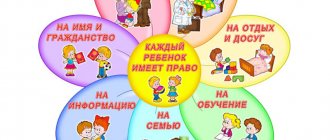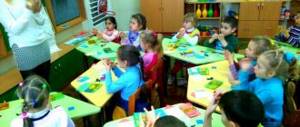Consultation for parents “Spring walks”
So winter with its frosts and colds has ended, the long-awaited spring has come and everything has changed: the hot sun warms the city, cheerful streams gurgle.
The heart itself rejoices along with nature. This feeling is familiar to all of us, and we so want to share it with the most dear person - our child. There are a lot of interesting changes in nature in spring, and it will be very useful if you show them to your baby. Stop, look at what surrounds you everywhere, and your imagination itself will tell you how to become a participant in the general joyful bustle. Where to look, what to raise, what to listen to. This will develop curiosity, imagination, and love for nature.
What to do with a child on a walk in the spring?
- "Count the birds." In spring, nature comes alive. And even if the leaves have not yet appeared, the birds have already begun to enjoy the warmth and smells that the spring air is rich in. With a child who can count, you can play the following game: who will notice more birds during a walk. You can finish the game as follows: feed the birds millet or special food.
- "Lilliputian Steps" This game is good for several children or the whole family to play. Choose a goal and mark a starting line. Let the players compete: who will cover the distance faster with Lilliputian steps (these are steps when a leg is placed close to the other leg during a step).
"Giant Steps" The meaning of the game is the same. However, now the child must spread his legs as wide as he can (adults may give in a little...).
- "Let's let in the sunbeams." If the weather is sunny, don't forget to take a mirror with you. The baby will be happy to make the day even sunny by letting the sun shine on houses and trees. Choose some distant target and practice who can launch the bunny that far.
- "Let's go swimming in the puddle." Make boats at home or on a walk, and then launch them in the nearest puddle.
- "Let's let the bubbles... float!" You can let not only boats sail through puddles, but also soap bubbles. They will last longer on the water and shimmer with all the colors. Watching such swimmers is a real pleasure.
- “Looking for the first signs of spring.” Arm yourself with a camera and go in search of spring. The first swollen buds, lively birds - all these are the first signs that spring is coming.
- "Drawing on the asphalt." If the asphalt is dry, it's time to take out the crayons and draw an invitation to spring: sun, flowers and grass. Perhaps this will speed up the arrival of heat!
- "Hunt for words and letters." If the child knows the letters, you can play a game where the child and the adult look around for objects that begin with the selected letter. You can choose different letters. For example, you are looking for words starting with the letter “a”, and the child is looking for words starting with the letter “m”. Who will find the most items?
- “Developing speed and coordination.” This game is very famous. The rules are simple: children stand between the two leaders, their goal is to knock the players out of the center with the ball. It is best to take an inflatable ball so as not to injure children. Take a larger ball, then the task for the kids will become much more difficult, and the risk of injury will decrease.
- “Developing coordination.” Participants stand opposite the leader. The game is very simple. All children must show movements opposite to those shown by the leader. For example, if the leader lowers his hands, the kids should raise them, if the leader crouches, the children should jump, etc. If the kid makes a mistake three times, he is eliminated. The winner is the one who can survive the longest.
- “Developing balance.” For this exercise, you need to place two children opposite each other at a distance of 2-3 child steps. At the signal, one, standing on one leg, with his palms outstretched, should hit the palms of the other baby. The essence of the game is to unbalance your opponent. The one who touches the ground first loses.
- “We are developing the speed of movement.” For this game you need a ball and chalk. On the asphalt, draw a circle with a diameter of about 2 meters and indicate the directions of movement. The child stands in the center and hits the ball on the ground, after which he runs away in the given direction. While the ball makes 3 hits, the baby must run. The one who runs farthest wins. This game is group, but can also be played alone.
Outdoor games are always fun and exciting!
Play with your child - this strengthens the bond between parents and children, and also helps create more reliable, trusting relationships in the family. We remember from childhood that “the sun, air and water are our best friends.”
It’s just a matter of making sure that our kids grow up surrounded by these faithful “comrades” from the very first days!
Dear parents!
We hope that this material will help you develop and strengthen the experience of safe behavior in your children, which will help them to anticipate dangers and, if possible, avoid them.
Child safety in summer.
The long-awaited summer has arrived! Children spend more and more time on the street, at the dacha with their parents, and go on vacation to the forest and water bodies.
Summer is characterized by an increase in physical activity and an increase in the child’s physical capabilities, which, combined with increased curiosity and the desire for independence, often lead to dangerous situations.
Preventing childhood injuries is one of the most pressing problems of our time. Adults are responsible for the life and health of children, and first of all, it is parents who must create safe living conditions for children in the summer, develop their safe behavior skills and the ability to foresee the consequences of dangerous situations.
The main thing that parents should remember is that under no circumstances should they leave their child unattended. You can protect yourself and your children from the many problems that a family may face if you are always concerned about safety.
Many measures to ensure the safety of children may seem elementary, but with a preschool-age child it is necessary to understand and discuss the seemingly very simple rules of behavior at first glance.
It is necessary to highlight some rules of behavior that children must strictly follow, since their health and safety depend on this.
Open windows.
Despite the fact that the topic of window safety has been raised more than once in the press, on television, on Internet platforms and in conversations, many parents believe that this simply cannot happen to their child. The firm belief that a strict prohibition was sufficient to protect the child brought a lot of grief. However, prohibitions continue to be one of the most common ways to “protect” a child. Meanwhile, every summer dozens of children who have fallen from a window are delivered to city hospitals, whose ages range from one and a half to ten years. That is, most of the affected children understand the danger that threatens them, but still violate parental prohibitions. Since you can’t count on a child’s awareness, parents need to take additional steps for their children’s safety: - Don’t trust mosquito nets.
— If you have a choice, install windows whose sashes open in an inclined position.
— Do not use protective products on windows that you can open easily.
— Remove regular handles from windows and replace them with handles with a built-in lock.
Children's safety on the water.
The main safety condition is to swim accompanied by an adult. It is necessary to explain to your child why you should not swim in an unfamiliar place, especially where there are no other vacationers. The bottom of a reservoir can be fraught with many dangers: submerged snags, sharp fragments, cold springs and deep holes.
Before you go into the water, you need to observe what it looks like. If the color and smell of the water are not the same as usual, it is better to refrain from swimming.
Children must also firmly understand the following rules:
playing on the water is dangerous (you cannot, even playfully, “drown” your friends or “hide” under water);
It is strictly forbidden to jump into water in places not intended for this;
you cannot dive or swim in places overgrown with algae;
you should not swim far on inflatable mattresses and rings;
You should not call for help as a joke.
Safe behavior in the forest.
A walk in the forest is a very good vacation, which improves health and introduces the child to his native nature. But there are some rules that adults must familiarize the child with, since the forest can be fraught with danger.
Tell your child about poisonous mushrooms and plants that grow in the forest, fields and meadows. Explain that you need to be careful and unlearn the bad habit of trying everything (grass berries). To consolidate knowledge, it is useful to use classification board games, appropriate visual material, and in the summer season, while walking in the forest, show poisonous plants and mushrooms. It is necessary to develop in children the need to communicate with their parents, the ability to overcome shyness when contacting adults when symptoms of poisoning appear.
Remind your child that under no circumstances should he walk through the forest alone; he should always stay close to his parents. But what if he got carried away with something and didn’t notice how lost he was?
Explain to your child that there is no need to panic and run away. As soon as you have lost your parents, you should shout louder so that you can find each other by voice, and stay in place. The child must know for sure that they will definitely look for him.
Safety when interacting with animals.
Children need to be instilled not only with a love for animals, but also with respect for their way of life.
It is necessary to explain to children what can and cannot be done when in contact with animals. For example, you can feed stray dogs and cats, but you cannot touch or pick them up. You must not approach unfamiliar dogs, disturb them while sleeping, eating, caring for puppies, or take away what the dogs are playing with. Remind children that both cats and dogs transmit diseases to people - lichen, scabies, rabies. After petting an animal, be sure to wash your hands with soap.
If you are bitten by a dog or cat, you should immediately tell your parents so that they can immediately take you to a doctor.
Also, children need to be given knowledge about insects, and reminded that even beneficial insects (bees, ants) can cause harm.
Overheating (heatstroke), sunstroke, sunburn.
Another danger of summer lies in its main advantages: warmth and abundance of sun. As a result, it is in the summer that heat and sunstroke, as well as sunburn, often occur.
Heat stroke is perhaps the most insidious. Unlike sunny weather, it can also happen in cloudy but hot weather. Symptoms can range from severe headache and nausea to weakness and drowsiness, and very often it is mistaken for the onset of some kind of cold or poisoning. To prevent heatstroke, first of all, try to avoid stuffy and hot rooms and public transport in hot weather. The hottest time of the day is best spent at home, and walking in the morning and evening. Dress your child in light, light-colored cotton clothing. Give as much fluid as possible, give preference to liquid foods. Always have a water bottle ready. At the slightest sign of discomfort or complaints of stuffiness, give the child a drink. Avoid sugary drinks (sparkling water, juices, etc.) - they do not quench your thirst properly. Try to feed your child light foods in hot weather, avoid fatty foods - they increase the likelihood of the body overheating. If this happens, immediately move the child to the shade. Place a cold compress on your head. Remove all excess clothing from your child. If there are signs of loss of consciousness, give the patient a cotton swab soaked in ammonia to sniff. Try to create an influx of fresh air by fanning the child with any object that can be used as a fan.
Contact an ambulance and describe your symptoms. In most cases, these measures should be sufficient, but severe heatstroke may require hospitalization. Sunstroke occurs less frequently, only in bright sunny weather. But its consequences are more dangerous. If heatstroke is simply a consequence of overheating, then sunstroke is a disruption of the central nervous system due to overheating of the head. Its symptoms are more clear and understandable than those of heat: general weakness, headache, fever, nausea, rapid pulse, in some cases, nosebleeds and fainting.
Preventing sunstroke is quite simple. Avoid walking during the hottest and sunniest time of day (11 a.m. to 3 p.m.). Make sure that in hot sunny weather the child is always outside wearing only a hat. Dress your child strictly according to the weather, avoid synthetic fabrics. Make sure your child gets enough unsweetened drinks.
If a child does receive a sunstroke, first aid measures in this case should be the same as for heatstroke.
Sunburn. Children's skin is more susceptible to sunlight than adult skin. Therefore, the child is more susceptible to sunburn.
To prevent sunburn, the first step is to avoid exposing your baby's skin to direct sunlight during the hottest part of the day. When going outside, dress your child according to the weather. On the beach, be sure to use a sunscreen with an SPF of at least 20 units (for fair-skinned children and children with sensitive skin - at least 30 units). Renew the cream every 2-3 hours until the child has his own even tan. Try to ensure that your child wipes himself off immediately after bathing and does not run around with wet skin.
If your child does get a sunburn, provide first aid immediately. Take your child to the shade and inspect the burns. Simply lubricate very reddened skin with after-sun product, and you can provide more serious assistance at home. Treat skin that is burned to blisters as if it were a thermal burn.
Fire safety.
A fire can occur anywhere and at any time. Therefore, you need to be prepared for it. The main thing to remember is that matches and lighters are used for household chores, but not for playing. Even a small spark can lead to big trouble anywhere, even on the street. Reinforce fire safety rules with your children:
Do not play with matches, do not make fires!
Do not turn on electrical appliances if adults are not at home!
Do not open the oven door!
Do not throw empty jars and bottles of household chemicals, especially aerosols, into the fire!
Do not play with gasoline or other flammable substances!
Never hide in case of fire, either under the bed or in the closet!
In case of fire, call 01, 112 (give your address, phone number, last name and tell what is burning)!
Don't play with fire!
Keep an eye on your child.
Children walking away from you or on their own are at risk of getting lost or stolen. Explain to children the rules of behavior around strangers. If you are in the forest, do not let your children go far from you, they may play too much and get lost. When in a crowd, always keep your child close to you, do not leave small children under the supervision of strangers, even if it is a “dear aunt”. Attackers may well use such an image for kidnapping.





